
Matplotlib Basics
Overview
We will cover the basics of plotting within Python, using the Matplotlib library, including a few different plots available within the library.
Why Matplotlib?
Figure and axes
Basic line plots
Labels and grid lines
Customizing colors
Subplots
Scatterplots
Displaying Images
Contour and filled contour plots.
Prerequisites
Concepts |
Importance |
Notes |
|---|---|---|
Necessary |
||
MATLAB plotting experience |
Helpful |
Time to Learn: 30 minutes
Imports
Let’s import the Matplotlib library’s pyplot interface; this interface is the simplest way to create new Matplotlib figures. To shorten this long name, we import it as plt to keep things short but clear.
import matplotlib.pyplot as plt
import numpy as np
Info
Matplotlib is a Python 2D plotting library which produces publication quality figures in a variety of hard-copy formats and interactive environments across platforms.
Generate test data using NumPy
Now we generate some data to use while experimenting with plotting:
times = np.array(
[
93.0,
96.0,
99.0,
102.0,
105.0,
108.0,
111.0,
114.0,
117.0,
120.0,
123.0,
126.0,
129.0,
132.0,
135.0,
138.0,
141.0,
144.0,
147.0,
150.0,
153.0,
156.0,
159.0,
162.0,
]
)
temps = np.array(
[
310.7,
308.0,
296.4,
289.5,
288.5,
287.1,
301.1,
308.3,
311.5,
305.1,
295.6,
292.4,
290.4,
289.1,
299.4,
307.9,
316.6,
293.9,
291.2,
289.8,
287.1,
285.8,
303.3,
310.0,
]
)
Figure and Axes
Now let’s make our first plot with Matplotlib. Matplotlib has two core objects: the Figure and the Axes. The Axes is an individual plot with an x-axis, a y-axis, labels, etc; it has all of the various plotting methods we use. A Figure holds one or more Axes on which we draw; think of the Figure as the level at which things are saved to files (e.g. PNG, SVG)
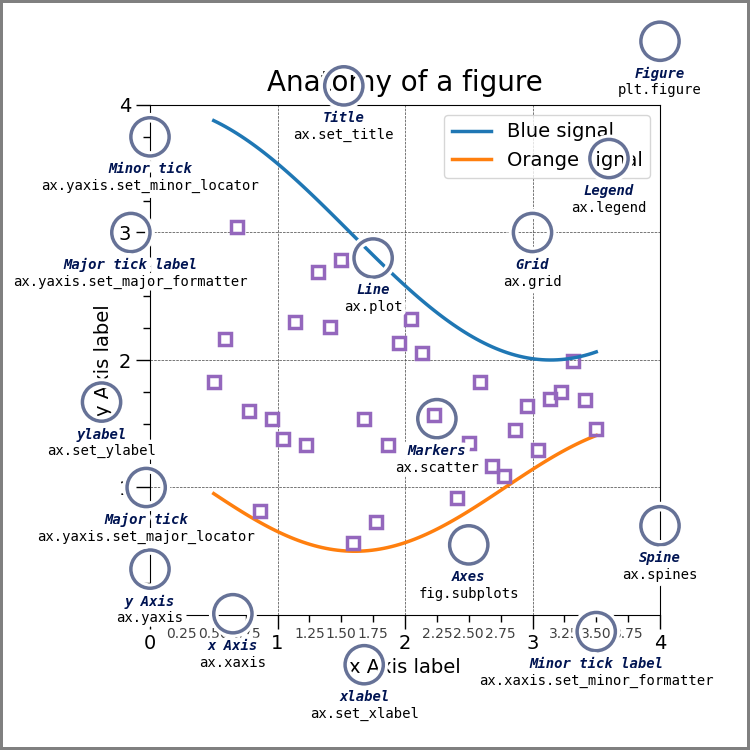
Basic Line Plots
Let’s create a Figure whose dimensions, if printed out on hardcopy, would be 10 inches wide and 6 inches long (assuming a landscape orientation). We then create an Axes, consisting of a single subplot, on the Figure. After that, we call plot, with times as the data along the x-axis (independent values) and temps as the data along the y-axis (the dependent values).
Info
By default, ax.plot will create a line plot, as seen below
# Create a figure
fig = plt.figure(figsize=(10, 6))
# Ask, out of a 1x1 grid of plots, the first axes.
ax = fig.add_subplot(1, 1, 1)
# Plot times as x-variable and temperatures as y-variable
ax.plot(times, temps);

Labels and Grid Lines
Adding axes labels
Next, add x- and y-axis labels to our Axes object.
# Add some labels to the plot
ax.set_xlabel('Time')
ax.set_ylabel('Temperature')
# Prompt the notebook to re-display the figure after we modify it
fig

We can also add a title to the plot and increase the fontsize:
ax.set_title('GFS Temperature Forecast', size=16)
fig

Of course, we can do so much more…
We start by setting up another temperature array
temps_1000 = np.array(
[
316.0,
316.3,
308.9,
304.0,
302.0,
300.8,
306.2,
309.8,
313.5,
313.3,
308.3,
304.9,
301.0,
299.2,
302.6,
309.0,
311.8,
304.7,
304.6,
301.8,
300.6,
299.9,
306.3,
311.3,
]
)
Adding labels and a grid
Here we call plot more than once to plot multiple series of temperature on the same plot; when plotting we pass label to plot to facilitate automatic creation of legend labels. This is added with the legend call. We also add gridlines to the plot using the grid() call.
fig = plt.figure(figsize=(10, 6))
ax = fig.add_subplot(1, 1, 1)
# Plot two series of data
# The label argument is used when generating a legend.
ax.plot(times, temps, label='Temperature (surface)')
ax.plot(times, temps_1000, label='Temperature (1000 mb)')
# Add labels and title
ax.set_xlabel('Time')
ax.set_ylabel('Temperature')
ax.set_title('Temperature Forecast')
# Add gridlines
ax.grid(True)
# Add a legend to the upper left corner of the plot
ax.legend(loc='upper left');
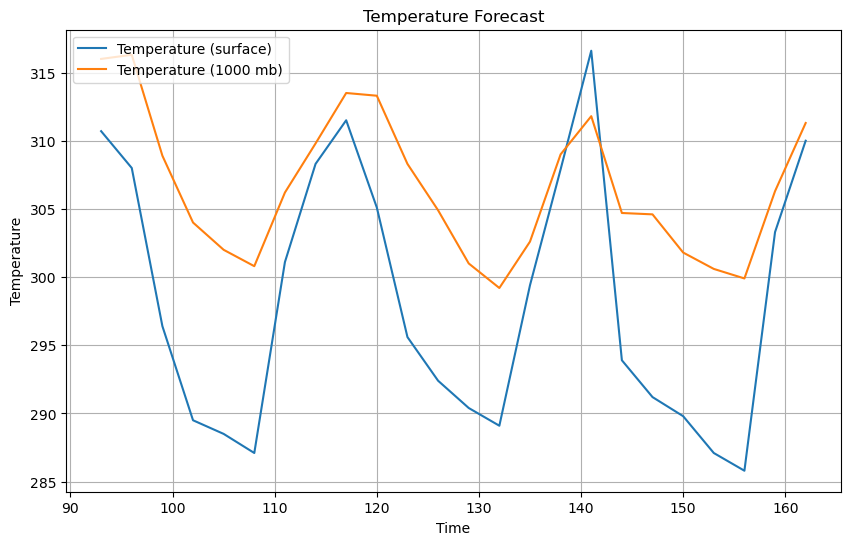
Customizing colors
We’re not restricted to the default look of the plots, but rather we can override style attributes, such as linestyle and color. color can accept a wide array of options for color, such as red or blue or HTML color codes. Here we use some different shades of red taken from the Tableau color set in Matplotlib, by using tab:red for color.
fig = plt.figure(figsize=(10, 6))
ax = fig.add_subplot(1, 1, 1)
# Specify how our lines should look
ax.plot(times, temps, color='tab:red', label='Temperature (surface)')
ax.plot(
times,
temps_1000,
color='tab:red',
linestyle='--',
label='Temperature (isobaric level)',
)
# Set the labels and title
ax.set_xlabel('Time')
ax.set_ylabel('Temperature')
ax.set_title('Temperature Forecast')
# Add the grid
ax.grid(True)
# Add a legend to the upper left corner of the plot
ax.legend(loc='upper left');

Subplots
Working with multiple panels in a figure
Start first with some more fake data - in this case, we add dewpoint data!
dewpoint = 0.9 * temps
dewpoint_1000 = 0.9 * temps_1000
Now, let’s plot it up, with the other temperature data!
Using add_subplot to create two different subplots within the figure
We can use the .add_subplot() method to add subplots to our figure! The subplot arguments are formatted as follows:
(rows, columns, subplot_number)
For example, if we want a single row, with two columns, we use the following code block
fig = plt.figure(figsize=(10, 6))
# Create a plot for temperature
ax = fig.add_subplot(1, 2, 1)
ax.plot(times, temps, color='tab:red')
# Create a plot for dewpoint
ax2 = fig.add_subplot(1, 2, 2)
ax2.plot(times, dewpoint, color='tab:green');

You can also use plot.subplots() with inputs nrows and ncolumns to initialize your subplot axes, ax.
Index your axes, as in ax[0].plot() to decide which subplot you’re plotting to.
fig, ax = plt.subplots(nrows=1, ncols=2, figsize=(10, 6))
ax[0].plot(times, temps, color='tab:red')
ax[1].plot(times, dewpoint, color='tab:green');
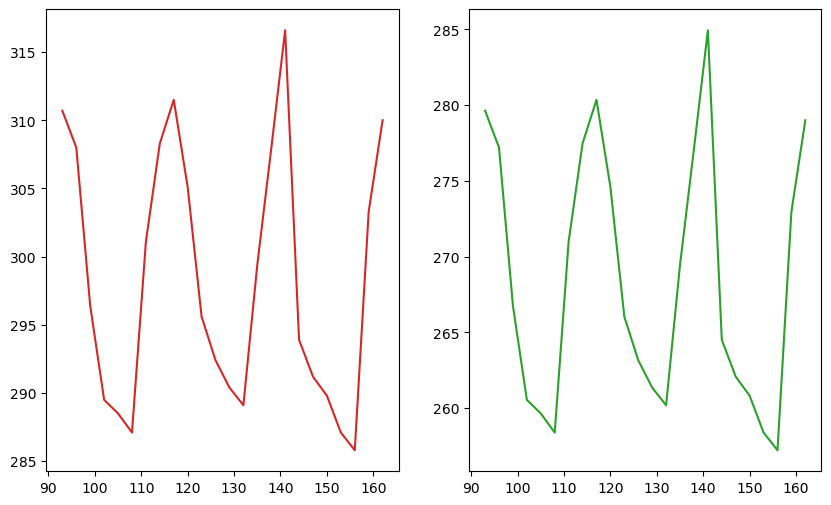
Adding titles to each subplot
We can add titles to these plots too - notice how these subplots are titled separately, each using ax.set_title after each subplot
fig = plt.figure(figsize=(10, 6))
# Create a plot for temperature
ax = fig.add_subplot(1, 2, 1)
ax.plot(times, temps, color='tab:red')
ax.set_title('Temperature')
# Create a plot for dewpoint
ax2 = fig.add_subplot(1, 2, 2)
ax2.plot(times, dewpoint, color='tab:green')
ax2.set_title('Dewpoint');
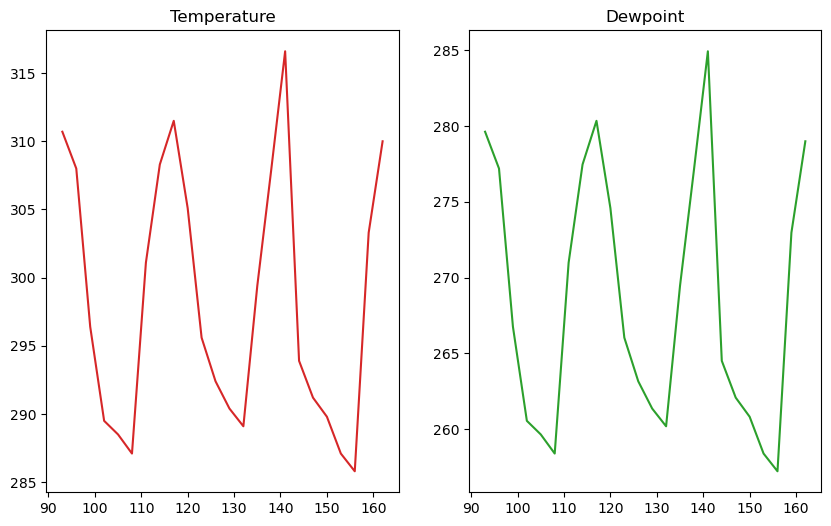
Using ax.set_xlim and ax.set_ylim to control the plot boundaries
You may want to limit the extent of each plot, which you can do by using .set_xlim and set_ylim on the axes you are editing
fig = plt.figure(figsize=(10, 6))
# Create a plot for temperature
ax = fig.add_subplot(1, 2, 1)
ax.plot(times, temps, color='tab:red')
ax.set_title('Temperature')
ax.set_xlim(110, 130)
ax.set_ylim(290, 315)
# Create a plot for dewpoint
ax2 = fig.add_subplot(1, 2, 2)
ax2.plot(times, dewpoint, color='tab:green')
ax2.set_title('Dewpoint')
ax2.set_xlim(110, 130);
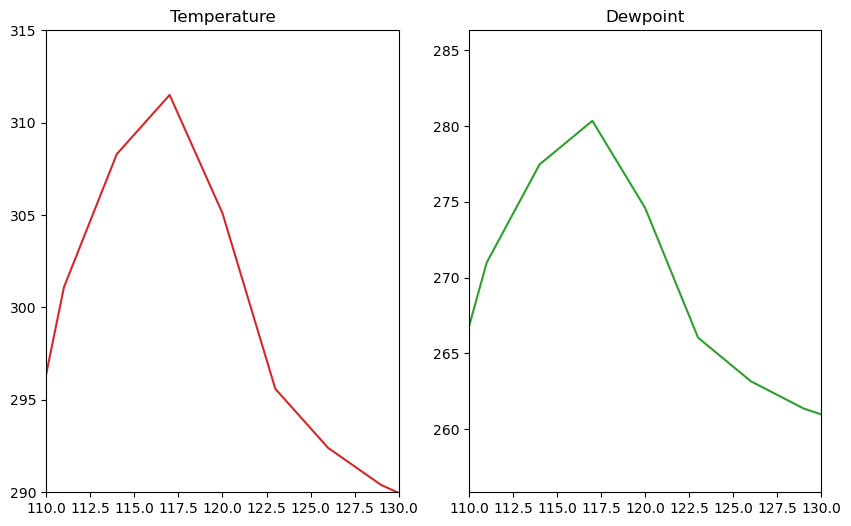
Putting this all together
Info
You may wish to move around the location of your legend - you can do this by changing the loc argument in ax.legend()
fig = plt.figure(figsize=(10, 6))
ax = fig.add_subplot(1, 2, 1)
# Specify how our lines should look
ax.plot(times, temps, color='tab:red', label='Temperature (surface)')
ax.plot(
times,
temps_1000,
color='tab:red',
linestyle=':',
label='Temperature (isobaric level)',
)
# Add labels, grid, and legend
ax.set_xlabel('Time')
ax.set_ylabel('Temperature')
ax.set_title('Temperature Forecast')
ax.grid(True)
ax.legend(loc='upper left')
ax.set_ylim(257, 312)
ax.set_xlim(95, 162)
# Add our second plot - for dewpoint, changing the colors and labels
ax2 = fig.add_subplot(1, 2, 2, sharex=ax, sharey=ax)
ax2.plot(times, dewpoint, color='tab:green', label='Dewpoint (surface)')
ax2.plot(
times,
dewpoint_1000,
color='tab:green',
linestyle=':',
marker='o',
label='Dewpoint (isobaric level)',
)
ax2.set_xlabel('Time')
ax2.set_ylabel('Dewpoint')
ax2.set_title('Dewpoint Forecast')
ax2.grid(True)
ax2.legend(loc='upper left');

Scatterplot
Maybe it doesn’t make sense to plot your data as a line plot, but with markers (aka scatter plot). We can do this by setting the linestyle to None and specifying a marker type, size, color, etc.
fig = plt.figure(figsize=(10, 6))
ax = fig.add_subplot(1, 1, 1)
# Specify no line with circle markers
ax.plot(temps, temps_1000, linestyle='None', marker='o', markersize=5)
ax.set_xlabel('Temperature (surface)')
ax.set_ylabel('Temperature (1000 hPa)')
ax.set_title('Temperature Cross Plot')
ax.grid(True);
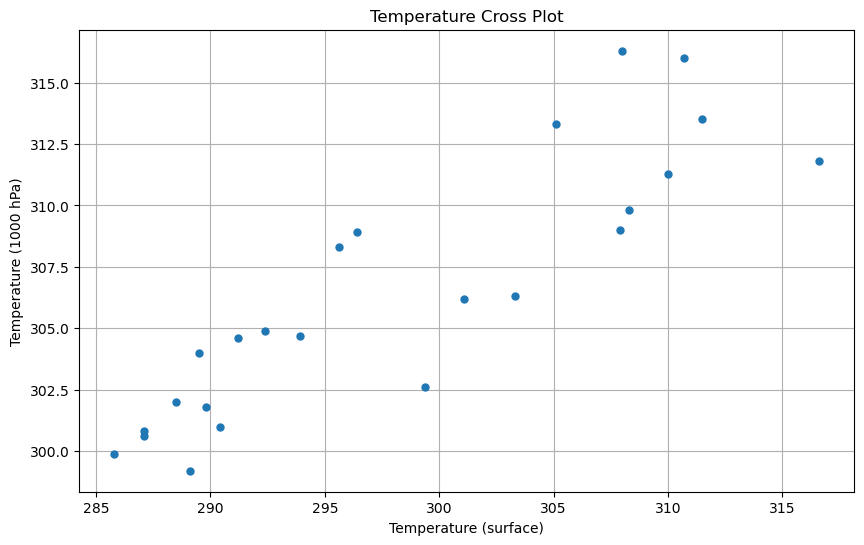
Info
You can also use the scatter method, which is slower, but will give you more control, such as being able to color the points individually based upon a third variable.
fig = plt.figure(figsize=(10, 6))
ax = fig.add_subplot(1, 1, 1)
# Specify no line with circle markers
ax.scatter(temps, temps_1000)
ax.set_xlabel('Temperature (surface)')
ax.set_ylabel('Temperature (1000 hPa)')
ax.set_title('Temperature Cross Plot')
ax.grid(True);

Let’s put together the following:
Beginning with our code above, add the
ckeyword argument to thescattercall and color the points by the difference between the surface and 1000 hPa temperature.Add a 1:1 line to the plot (slope of 1, intercept of zero). Use a black dashed line.
Change the color map to be something more appropriate for this plot.
Add a colorbar to the plot (have a look at the Matplotlib documentation for help).
fig = plt.figure(figsize=(10, 6))
ax = fig.add_subplot(1, 1, 1)
ax.plot([285, 320], [285, 320], color='black', linestyle='--')
s = ax.scatter(temps, temps_1000, c=(temps - temps_1000), cmap='bwr', vmin=-5, vmax=5)
fig.colorbar(s)
ax.set_xlabel('Temperature (surface)')
ax.set_ylabel('Temperature (1000 hPa)')
ax.set_title('Temperature Cross Plot')
ax.grid(True);
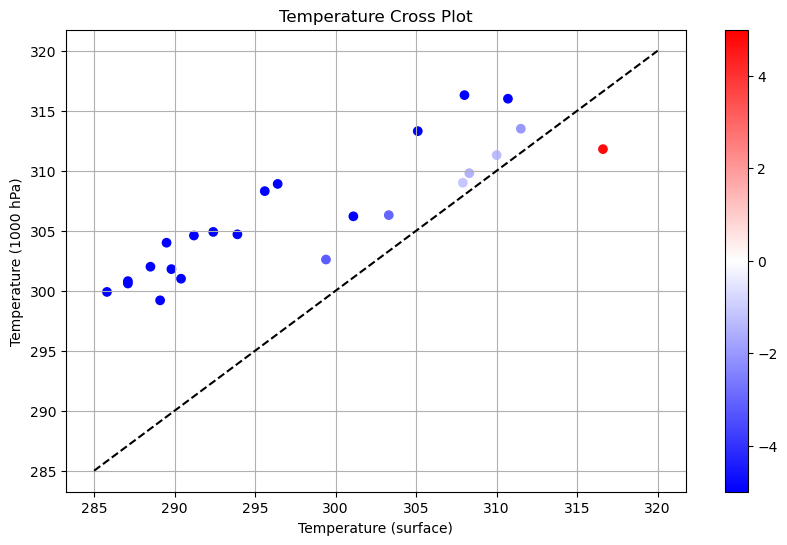
Displaying Images
imshow displays the values in an array as colored pixels, similar to a heat map.
Here is some fake data to work with - let’s use a bivariate normal distribution.
x = y = np.arange(-3.0, 3.0, 0.025)
X, Y = np.meshgrid(x, y)
Z1 = np.exp(-(X**2) - Y**2)
Z2 = np.exp(-((X - 1) ** 2) - (Y - 1) ** 2)
Z = (Z1 - Z2) * 2
Let’s start with a simple imshow plot.
fig, ax = plt.subplots()
im = ax.imshow(
Z, interpolation='bilinear', cmap='RdYlGn', origin='lower', extent=[-3, 3, -3, 3]
)
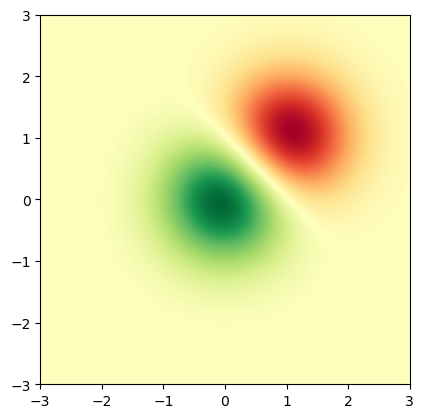
Contour and Filled Contour Plots
contourcreates contours around data.contourfcreates filled contours around data.
We can also create contours around the data.
fig, ax = plt.subplots()
ax.contour(X, Y, Z);
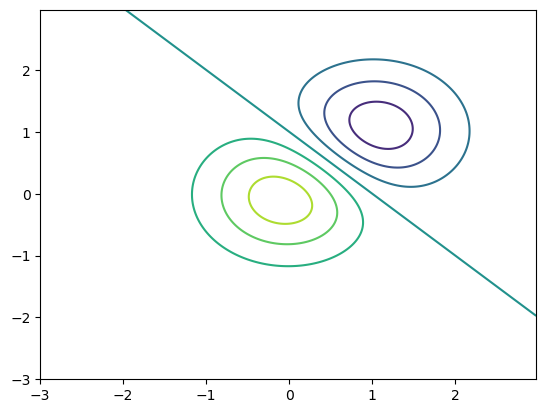
Now let’s label our contour lines
fig, ax = plt.subplots()
c = ax.contour(X, Y, Z, levels=np.arange(-2, 2, 0.25))
ax.clabel(c);

The contourf method stands for contour fill, which fills in the contours!
fig, ax = plt.subplots()
c = ax.contourf(X, Y, Z);

Finally, let’s create a figure using imshow and contour that is a heatmap in the colormap of our choice, then overlay black contours with a 0.5 contour interval.
fig, ax = plt.subplots()
im = ax.imshow(
Z, interpolation='bilinear', cmap='PiYG', origin='lower', extent=[-3, 3, -3, 3]
)
c = ax.contour(X, Y, Z, levels=np.arange(-2, 2, 0.5), colors='black')
ax.clabel(c);
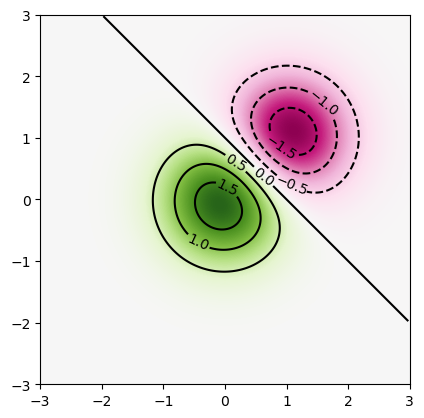
Summary
Matplotlibcan be used to visualize datasets you are working withYou can customize various features such as labels and styles
There are a wide variety of plotting options available, including (but not limited to)
Line plots (
plot)Scatter plots (
scatter)Imshow (
imshow)Contour line and contour fill plots (
contour,contourf)
What’s Next?
More plotting functionality such as histograms, pie charts, and animation.
